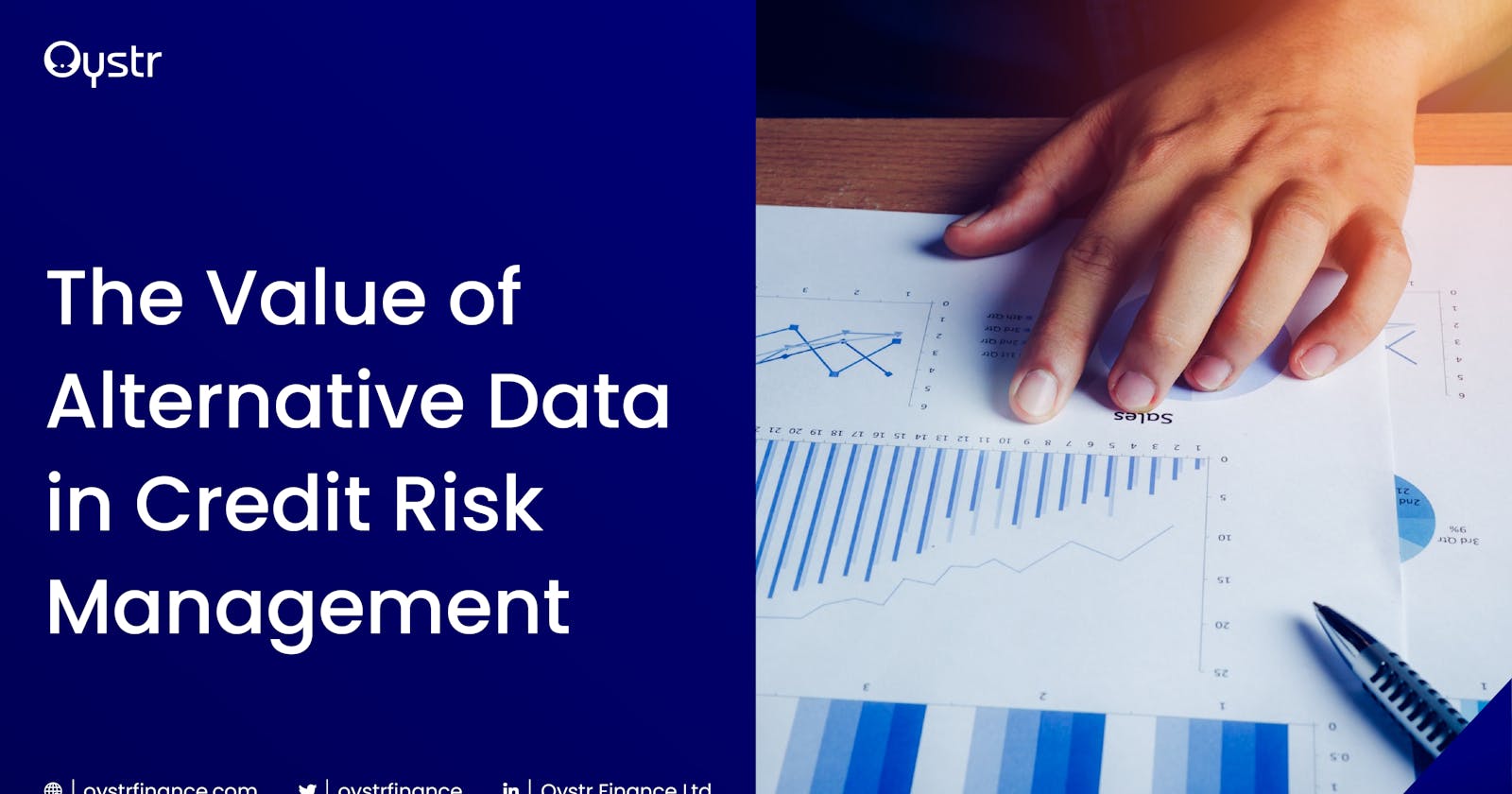Credit risk is a major part of nearly every banking and lending operation. Businesses and e-stores, BNPL companies also face similar challenges in credit risk management, and alternative data poses a valuable solution to mitigating such risk.
The provision of credit to various customers involves a lot of money and an inevitable amount of risk such as non-fulfilment of repayment terms.
Hence, creditors bear the heavy weight of assessing their customers and other internal and external factors for threats. Largely because different conditions implicate credit risks such as regulatory settings, the institutions' internal controls, and the market within which it operates. They turn to methods such as strict requirements, tedious paperwork, heavy collateral, high interest, etc.
The traditional procedures for measuring credit risk have certain weaknesses which makes it inefficient to accurately assess customers. As a result, experts sought to discover and develop credit risk management solutions. Tools and technologies such as data analytics and modelling, artificial intelligence, machine learning, and alternative data credit scoring, are now leveraged to mitigate risk.
Image source: trulyoffice.com
Data and Managing Credit Risk: How Valuable Is Alternative Data?
Data serves as the most important element required for managing risk. Credit Risk Management is a fundamental operation for banks and non-bank financial institutions like lending and insurance companies. The credit risk management process involves the identification, assessment, finding solutions and taking actions to manage and mitigate credit risk.
Today, billions of individuals generate infinite volumes of heterogeneous data as a result of cell phone penetration and skyrocketed digital usage. Technology advancements also continue to propel innovations in FinTech. The abundance of data and development in artificial intelligence and computation empower financial institutions to assess credit risk profiles through analytics.
In the past, banks and credit or insurance companies employed conventional data such as financial records, credit history, demographic information, etc. in their risk management process. They used indicators like credit scores, market-based metrics, and accounting ratios to assess customer risk profiles.
Customers required loads of paperwork to access loans, while organisations strived to fulfil strict provisions that only gave lenders shallow insights. As a result, risk profiles were not always assessed accurately, leaving a huge gap in the heart of credit risk analysis.
However, alternative data thrives in filling the information gap left by inadequate traditional data and brings a new approach to risk management.
Alternative data offers access to new, rich, and unique sources of deep user behaviour insights. Leveraging big data analytics and machine learning helps with evaluating, managing and impeding credit. It adds immense value to the credit risk management process and creates valuable credit scoring for even the unbanked.
However, depending on how efficiently it is extracted and integrated. Effective extraction delivers defining, illustrative, and predictive advantages that help both lenders and their customers achieve their goals.
The best credit risk management combines alternative data with traditional data to capture an absolute picture of credit risk and create an extensive management structure.
The Valuable Merits of Alternative Data In Credit Risk Management
Here are some of the amazing benefits alternative data providers offer to businesses and financial institutions. and its value in credit risk analysis.
Accurate Credit Scoring
Alternative data, combined with machine learning and analytics, displays better performance in measuring creditworthiness than traditional analysis of balance sheet data and customer files. It allows different sources of information to be analyzed in real-time to give a complete report of a customer's creditworthiness and assign accurate credit scores.

Individual personal, psychological, and socioeconomic attributes often compare to their financial tendencies and repayment behaviour. Alt data (e.g. social media activity, online purchases) reflect these individual peculiarities that affect customer tendencies, which traditional data overlook. It facilitates accurate scoring and helps to control for such influences while building a risk profile.
Predictive Knowledge
According to FICO research, alternative credit data sources add predictive value when incorporated into credit risk models. The ability to make accurate predictions of the factors that affect risk stands as alternative data's biggest value to credit risk analysis. When financial services providers can foretell customer behaviour, market trends, regulatory adjustments, and more, risk management becomes a walk in the park.
Alternative data enhance the predictive accuracy of customers' default behaviour and the impact of external factors or changes. That is, analyzing alternative data enables the projection of probable events that may affect customers, and help presume their solvency. Moreover, it confers higher predictive capability compared to traditional data for unbanked populations and thin-file customers who lack credit history.
Competitive Advantage and Good Financial Returns
Gaining market advantage places any institution above competitors and even poor market conditions. When risks are accurately identified, they are more easily avoided, prevented, or managed. Properly extracted and analyzed alternative data gives a competitive edge that is handsomely compensated by substantial profits.
Strengthening Risk Models
Using alternative data encourages the building of machine learning models for credit risk prediction. It provides verified, credible insights for establishing customers' credit scores and reveals other hidden insights. Utilizing alt data helps to identify weak information signals by offering unique perspectives that correlate with different data sources.
It strengthens risk models with deep insights and predictive knowledge that deepen their accuracy and fortitude. More so, machine learning brings excellent analytical frameworks that help in computing data accurately by identifying essential patterns in customer behaviour in various situations and conditions.

Alleviating Inequality in the Financial Services Market
The traditional credit risk assessment models and methods possess certain biases which automatically exclude certain groups of individuals and organizations. Training models using only conventional data or approved applications make it prone to favour higher-income customers and exclude lower-income, underserved populations.
Traditional approaches to credit scoring are unable to assess thin-file customers which makes credit risk assessment for the unbanked and underserved generally, difficult. However, alternative data shows great potential for ameliorating inequality in the financial service markets, and by extension, social inequality.
Since it contains data outside of bank files and balance sheets and traces digital footprints, the underserved receive better credit assessment. Alternative data scoring helps banks and other lending institutions extend their services and products to low-income, underserved customers.
Inclusive innovations such as Financial Identity as a Service (FiDaaS) use alternative data to create credit identities for underserved customers to receive more accurate scores and access to credit. Hence, it enhances credit risk management, drives financial inclusion and diminishes financial inequality while generating higher financial returns.
Expanding the Lending Services Industry and Overall Credit Performance
The use of alternative data encourages the introduction of new players and customers into the lending system. Since creditworthiness can be measured using sources of data other than historical financial records from banks, more players and customers are entering the industry.
The combination of alt data with machine learning techniques transforms credit risk analysis. This results in lesser processing time, reliable risk management structures and better delivery of affordable quality credit services.
Conclusion
The value of alternative data is best harnessed in combination with traditional data as complementary. When integrated with existing models, it generates multiple merits as discussed in this article. Alternative data potentially enhances credit risk assessment while aiding credit scoring for the unbanked.
Oystr Finance is one of the biggest alternative data providers in Africa. Integrating our data infrastructure will reduce your credit risk, and help you offer the right products to customers.
Visit our website to learn more.


